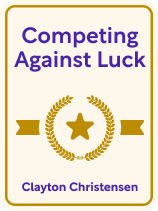

This article is an excerpt from the Shortform book guide to "Competing Against Luck" by Clayton Christensen. Shortform has the world's best summaries and analyses of books you should be reading.
Like this article? Sign up for a free trial here.
Want to learn about Competing Against Luck by Clayton Christensen? What does it take for a new product to be successful?
Unlock the secrets to launching successful products with Competing Against Luck by Clayton Christensen. No more relying on luck or guesswork—Christensen reveals a powerful framework for understanding consumer demand and the way people buy products to accomplish specific tasks.
Read on for an overview of Competing Against Luck: The Story of Innovation and Customer Choice by Clayton Christensen.
Competing Against Luck by Clayton Christensen
Is it possible to know for a fact how successful a new product will be before you take it to market? Is it possible to predict exactly what your customers want to buy, instead of guessing and hoping you’ll get lucky? According to Competing Against Luck by Clayton Christensen, the answer to these two questions is yes.
In Competing Against Luck, published in 2016, Christensen offers a conceptual framework for analyzing consumer demand and guiding product innovation. His main idea is that people buy products to accomplish specific tasks—for instance, if you want to have fun on a beach vacation, you might buy a surfboard or a fantasy novel to do the task for you. He developed this framework (that he calls “jobs theory”) over years of research and teaching, finally compiling his insights in Competing Against Luck.
Christensen argues that this theoretical framework is the best way to represent the motivations behind customers’ purchases. You can use this framework to spark innovative ideas for your business and verify whether they’ll succeed in the market. If you correctly identify a task that customers want to accomplish and design a product that does it for them, that product will be a guaranteed success.
By following this advice, you’ll find outsized success in any market. Without this framework guiding their idea generation, your competitors’ attempts at innovation will rely solely on luck—they’ll guess what customers want and hope that they’re lucky enough to be right.
(Shortform note: In Competing Against Luck, Clayton Christensen uses the term “jobs” to describe the motivating purposes behind consumers’ purchasing decisions. For clarity, we’ll be referring to these situation-dependent purposes as “tasks.”)
The Problem: Typical Innovation Strategies Don’t Work
In Competing Against Luck by Clayton Christensen, the author argues that the way most companies think about business innovation is misguided. Many business leaders assume that tracking the right metrics and gathering enough hard data will reveal what profitable products to design or how to make their products better. For instance, a clothing company may track what smartphone apps their customers use to try and learn what their target demographic wants. If the company sees that their customers spend 75% of their time on social media apps, they could interpret this as demand for social engagement and they might respond by adding chatrooms to their shopping app.
These companies spend an exorbitant amount of money on comprehensive data analytics to aid research and development, but often, their innovations fail to make their products much better for the consumer. Their investment is wasted, and any successful innovations they do produce are due to lucky guesses.
According to Christensen, hard data fail to reliably guide the creation of profitable innovations for two main reasons.
Problem #1: The Illusion of Objectivity
First, data fail to support innovation because they create the illusion of objectivity. Working with data feels like a hard, objective science, and any ideas for innovation that have numbers to back them up feel much more trustworthy. However, Christensen notes that data aren’t as objective as they seem. The ways that we measure metrics and collect data points often depend on numerous subjective decisions.
For example, imagine that a video streaming service like Hulu is trying to decide whether to pick up a new reality TV show. If they surveyed their existing subscribers to predict how many would watch it, mild differences in this survey process could result in different data sets. If the survey is attached to an enticing video teaser, for instance, it could inflate the numbers—a survey with the teaser may report that 75% of subscribers want to watch the show, while a survey with just a text description may report that only 45% of viewers want to watch it. Even though both surveys would offer seemingly objective numbers, they would both be subjective because they’re the result of arbitrary choices in the data collection process.
Problem #2: The Illusion of Success
Second, data often create the illusion of success. In Competing Against Luck by Clayton Christensen, the author explains that people tend to see what they want to see when interpreting data. For this reason, teams often interpret inconclusive data as evidence that they’ve successfully created the next big thing, and they consequently invest heavily in a launch doomed to fail.
For example, imagine Baskin-Robbins tries to innovate by offering ice cream wrapped in a burrito. They gather a significant amount of customer feedback that, in their eyes, indicates that this would be a success: The market for casual Tex-Mex food is growing, a huge percentage of their customers are interested in fusion cuisine, and so on. Unfortunately, although these data seem objective and positive, they’re likely masking the failure of a bad idea. These data don’t prove that people want a fusion of Tex-Mex and ice cream, specifically—you’d get the same data even if no one wants to eat a soggy ice cream burrito.
The Solution: How Consumer Tasks Guide Innovation
Clayton Christensen asserts in Competing Against Luck that successful leaders don’t use data to inspire innovative business decisions; instead, they use their subjective understanding of consumer tasks. Let’s take a closer look at Christensen’s idea of consumer tasks—the concept at the core of his framework for innovation.
What Are Tasks?
As mentioned earlier, Christensen defines a task as a specific purpose that customers accomplish by buying a product, such as “entertain me and help me forget about work during my vacation.” He explains that tasks are useful sources of insight about customers because they identify the root motivation behind a customer’s purchase, something that impersonal, often superficial data are ill-suited to accomplish.
Identifying consumer tasks comes with many benefits, notes Christensen. Once you’ve defined a task in detail, it’s much easier to come up with innovative ideas on how to better accomplish it. Additionally, you can predict whether an innovative product will succeed in the marketplace by judging how well it accomplishes that task.
How to Identify Your Customers’ Tasks
Now that we’ve defined what a consumer task is, let’s discuss how to use this information to generate profitable business innovations. The first step of innovation is to identify the task you’re trying to resolve with your product. Let’s discuss two of the suggestions for how to do this effectively, according to Competing Against Luck by Clayton Christensen.
Strategy #1: Interview Customers
One of the most reliable ways to identify tasks is to talk with customers, contends Christensen. Because tasks are so situation-dependent, you need a detailed picture of the customer’s life to fully understand the task that motivated them to make the purchase. A one-on-one conversation is the best way to uncover this level of detail.
To identify a task associated with a purchase in sufficient detail to inspire innovation, you need all the context from the customer’s life that’s relevant to that purchase. For any purchase that a customer makes, there are encouraging factors influencing them to buy it and opposing, discouraging factors influencing them not to buy it. The encouraging factors include the problems causing them pain and the attractive benefits of the new product. The discouraging factors are the existing, habitual ways the customer solves their problems and their doubts and fears about the new product (that it’ll be a waste of money or make their life worse).
Christensen recommends asking customers to tell you the story of their life leading up to a specific purchase and identifying the encouraging and discouraging factors at play, as they’re all components of the task driving the purchase.
For example, a customer might describe the last time he bought a winter coat: He was planning to take a trip to Canada to go camping with some friends. He thought about buying a warm, puffy winter coat. However, he worried that his friends would make fun of him, so he decided to buy a thin coat instead and ended up suffering through the bitter cold. Stories like this illuminate the encouraging factors (I want to be warm) and discouraging factors (I don’t want my friends to make fun of me) customers consider when making a purchase.
With this story, you could set out to design a coat that solves the following task: “Keep me warm in the cold outdoors without drawing too much attention to how I look.”
Strategy #2: Study the Tasks Around You
In Competing Against Luck by Clayton Christensen, the author maintains that as you go about your daily business, you’ll naturally encounter tasks that aren’t being done well. Every consistently difficult task in life is an opportunity for innovation, so keep your eyes open. Whenever you or someone around you encounters something frustrating or has tried and failed to resolve a specific task for an extended period of time, there’s a task that the market is failing to address.
In particular, Christensen recommends taking note if someone around you gets creative and devises a unique solution to a problem they have. People who invent DIY solutions are trying to resolve a task that no one has designed a product for yet, making it a golden opportunity for you to fill a gap in the market. For instance, if you see someone taping blankets over their windows to block out sunlight, you could design easy-to-install window blinds that stick directly to a window frame.
Similarly, pay attention if you see someone using a product to resolve a task that its designers didn’t intend, argues Christensen. Such mismatches often indicate that a version of the product designed for that task would be in high demand. For example, if you work for a sunglasses company and see someone using your sunglasses to block out blue light while working on a computer, it might be an opportunity to create a blue-light-blocking line of sunglasses.
How to Design a Product to Solve a Task
Once you’ve defined a consumer task in detail, design a product that accomplishes that task in a satisfying way. According to Clayton Christensen’s Competing Against Luck, the key to innovative design is to focus on selling a full experience, not just a product. Since every task is tied intrinsically to a specific situation, you can directly work to improve the experience of that specific time and place rather than focusing on features you can add to the product. This may involve extending your focus beyond the core functionality of your product and instead innovating the entire process of purchasing and using your product.
How to Center an Organization Around Consumer Tasks
Now that we’ve covered how to identify a task and design a product that solves one, we’ll explain how to build an effective organization by centering all its operations around the idea of the consumer task. Here are three task-oriented strategies organizations can use to thrive.
Strategy #1: Establish Repeatable Procedures to Accomplish a Consumer Task
Christensen argues that the end goal of all organizations should be to accomplish a specific customer task as well as possible. This includes designing an effective product and doing everything necessary to ensure that it satisfies the customers who buy it.
To that end, Christensen recommends identifying a series of procedures that, when completed, always result in a product that gets the customer’s task done satisfactorily. Then, repeat these procedures. Consistent procedures mean that even if individual members of your organization come and go, the result stays the same, guaranteeing customer satisfaction.
For example, if you’re selling a video game that solves the task “give me a thrilling, immersive second life I can escape to,” you must establish a procedure for how you’ll resolve bugs that could ruin the immersive experience. This procedure might be: First, identify and record the bug; then, create a solution and run it on test servers; and finally, upload it to the game and publish an announcement to the players. Following these instructions ensures that the team achieves consistent results every time.
Strategy #2: Assess Your Procedures With the Right Data
According to Christensen, tracking the right data is essential for ensuring that your organization consistently satisfies a consumer task. Although the wrong data can easily lead you astray (as we discussed earlier), metrics that are directly tied to a consumer task are necessary to assess whether your organization is successfully executing its procedures.
Helpful task-centric metrics are typically external rather than internal—that is, they directly reflect the results you deliver to the customer, rather than employee efforts. External metrics directly represent how well you’re satisfying the consumer task, while internal metrics are distanced from the consumer task and may paint a misleading picture of how well you operate.
Strategy #3: Use the Consumer Task to Guide All Employees
Once you’ve identified the consumer task your organization is trying to resolve, Clayton Christensen contends in Competing Against Luck that you can use that task as the rationale for every decision anyone in your organization makes. As long as a worker knows the task they’re trying to resolve, they’ll be able to weigh the pros and cons of any decision and act productively in complex situations. Rather than worrying about what they’re “supposed” to be doing, they can see for themselves what decisions would best satisfy the consumer and act accordingly. This allows managers to be more hands-off in directing their subordinates.
By contrast, other companies try to empower and inspire their workers with mission statements that are too vague for them to realistically use while making decisions on the job.

———End of Preview———
Like what you just read? Read the rest of the world's best book summary and analysis of Clayton Christensen's "Competing Against Luck" at Shortform.
Here's what you'll find in our full Competing Against Luck summary:
- How to analyze consumer demand to guide product innovation
- How you can design and sell a product that can't possibly fail
- Tips for increasing your company's chances of success






